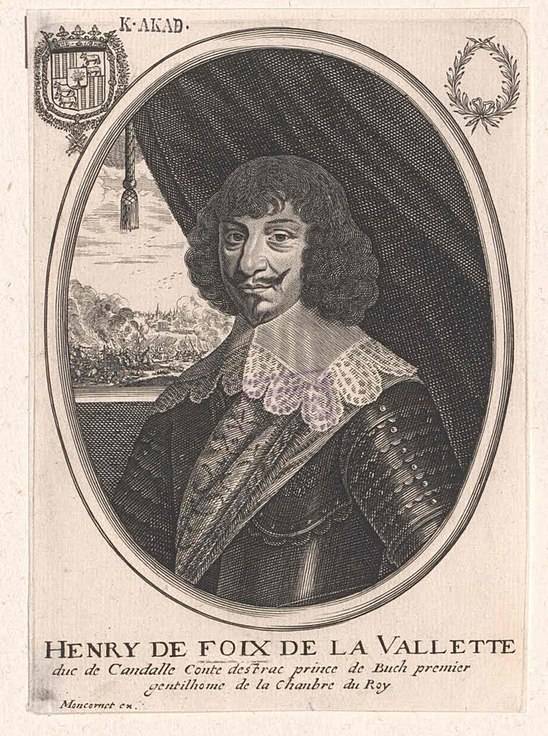another cardinal. 1637
According to Glagoleva's book "Louis XIII" (unfortunately, the author did not find more reliable information), she numbered 18 thousand people and had the primary task of liberating the fortresses captured by the Spaniards last year. His brother Henri de Nogaret, Duke de Kandal became La Valette's deputy, and among his subordinates, in addition to Turenne and de Guiche, were the future marshals de La Meyere (a talented artilleryman) and de Gassion.

Duke Henri de Candal
On June 21 (or 20) the troops of Cardinal La Valetta captured the fortress of Cato Cambresi after a three-day siege. The garrison of 200 people could not put up serious resistance. The next in line was the fortress of Landrecy. Its garrison consisted of 500 infantry and a company of cavalry.
But the fortress was located in a swampy area, and therefore, at first, they had to do drainage work - dig drainage ditches and fill dams. The idea was given by Turenne, who saw similar work during the siege of Hortagenbosch by his uncle Frederick-Hendrik van Oranje. After that, it was possible to calmly place artillery against the walls and dig an underground gallery to lay mines.
For about a week, artillery shelled the city, including bombs, which caused extensive fires. Finally, on July 22, a mine exploded under one of the bastions, which destroyed it and created a breach 40 paces wide.
On the evening of the same day, the commandant requested surrender, and on July 26, the garrison, reduced by half, left the city. On the occasion of the victory in Paris, they staged a festive procession carrying banners and other trophies.
Around the same time, i.e. July 23, Prince Frederik-Hendrik began the siege of Breda. Now the Cardinal Infante had to be torn between the north and south of the Spanish Netherlands. According to the same Glagoleva, he had 13 thousand infantry and 5 thousand cavalry. Initially, he tried to relieve the siege of Breda: on August 2, he stopped 9 km from the fortress. However, it turned out that the Dutch managed to build two lines of fortifications, including the outer one, as long as 34 km, to protect against the deblocking troops.
Therefore, after several inconclusive skirmishes on August 14, the Cardinal Infante retreated. After that, the Dutch, or rather, the allies - there were French and even English limited contingents, began a full-fledged siege. Moreover, unlike the previous Spanish siege, they did not wait until the garrison died of starvation, but brought mines and stormed the fortifications in turn. On October 6, the commandant of the fortress began negotiations for surrender.
Unable to help the garrison of Breda, the Cardinal Infante decided to strike elsewhere.
On August 25, Venlo was taken, and a week later - Roermond. The capture of these cities made it possible to isolate Maastricht from the United Provinces, but, of course, could not fully compensate for the loss of Breda. Now the Cardinal Infante decided to head south against the French. Moreover, French sources indicate that, in addition to the Spanish troops themselves, the imperial troops under the command of General Piccolomini fought against them.
It is known that this general, by the way, is quite intelligent, fought in Flanders during 1635-1638. His corps (conditionally, of course, real corps will appear only after 200 years) usually consisted of 10-15 thousand people. In the memoirs of Count de Guiche, there is a figure of 25 thousand infantry and 12 thousand cavalry, which looks like a clear exaggeration - with such an army (twice as large as that of the French), the Cardinal Infante simply had to arrange the last beating worse than under Nerdlingen.
On August 5, French troops took Maubeuge, perhaps without resistance at all. After this, Cardinal La Valette left a garrison in the city, led by Turenne, and part of the army under the command of his brother, and at the beginning of September, with the rest, went to besiege the fortress of La Capelle. The siege began on 14 September.
Also in early September, the army of the Cardinal Infante appeared in the vicinity of Maubeuge. For some time she remained near the city, as if about to storm it, but then moved towards La Capelli. The army of the cardinal, occupied with the siege of the fortress, was in danger of defeat (two years later this happened with another French army at the fortress of Thionville). Moreover, the Count de Guiche in his memoirs directly accuses the Duke de Kandal that he was not in a hurry to help his brother.
But, to the joyful amazement of the French, the commandant of La Capelli turned out to be a coward, which was a unique phenomenon for the Spanish army and, without waiting for reinforcements already sent, surrendered the fortress after only 8 days of siege. True, this did not help the commandant himself, because the infant cardinal ordered that his head be cut off. But the opportune moment for the attack was missed, and Don Fernando decided to return to Maubeuge.
Up to this point, all sources state approximately the same. But with regard to Maubeuge, there are some differences.
Stephen Thion's book The French Army in the Thirty Years' War states that the Infante Cardinal drove the French south of Maubeuge without any details of the process. Biographies of Turenne describe how the Spaniards stormed the city, but the future marshal repulsed them. Machine translation from French, especially from Old French, is too clumsy to understand the details. Therefore, we have to accept the most probable.

Viscount Henri de Turenne
The Cardinal Infante left a barrier at the bridge over the Sambre River in order to prevent the brothers from joining, and went back to Maubeuge - either to storm the city itself, or to attack the Duke of Kandal, who was in its vicinity. In any case, La Valette managed to get through to the city, and the Spanish were eventually forced to retreat. According to de Guiche's memoirs, the French managed to coordinate the offensive of La Valette, Kandal and Turenne, who made a successful sortie from the fortress.
On site Maubeuge, city, story and heritage, habitat (villesetvillagesdelavesnois.org) the fighting is described as follows.
Cardinal de La Valette, commander of the French troops, captured Maubeuge in August 1637, placed a strong garrison there, then ravaged the country on the side of Mons and went to besiege La Capelle. During this last operation, the Cardinal Infante, governor of the Netherlands, advanced to fight the French corps under the command of the Duke of Candal, who dug in under the protection of the city artillery of Maubeuge. The latter locked his troops in the fortress, where Viscount Turenne commanded. Then the Infante attacked the fortress with 30 guns.
Learning that the fortress of La Capelle had been surrendered and that Callet (La Valette) was approaching him, he launched a general offensive; but Turenne defended himself valiantly, repelled the enemy, and forced him to raise the siege, suffering considerable losses in killed or drowned while crossing the Sambre.
Gabriel Anoto, in his book The History of Richelieu, writes that Cardinal La Valette decided that it was too dangerous to leave a garrison in Maubeuge and therefore withdrew it, having previously razed the city fortifications to the ground. This may explain the phrase about the Cardinal Infante who drove the French away. But, obviously, Don Fernando did not need such a suitcase without a handle, because it is known that the Spaniards took the city only in 1641. It must be said that King Louis XIII was dissatisfied not so much with the "demilitarization" and the abandonment of Maubeuge, but with the haste with which it was carried out - so that it was not possible to take out all the food supplies.
Since La Valette did not plan anything else significant until the end of the campaign, the king ordered him to transfer part of the army to Marshal Châtillon for the siege of Damvilliers, which was taken on October 27.
In general, the campaign of 1637 for Cardinal La Valette was quite successful. In addition to the fortresses already mentioned, several others were taken, such as Beaumont, Saint-Paul, Berlaymont and Solra, and the whole region of Hainaut was devastated. We also managed to help the Dutch allies. We can say that the duel between Cardinal Infanta and just Cardinal La Valetta ended in victory on points for the latter.
As for other events of this year, there were both joyful events and sorrows.
The Spanish attempt to invade France through the Pyrenees failed miserably - their army was defeated at Leucate. It was finally possible to liberate the Lerins Islands, while Spanish stubbornness only led to heavy losses - more than 3 thousand killed out of 4 thousand in two garrisons. Henri d'Harcourt distinguished himself - in the future one of the most talented commanders of the Thirty Years' War.
In the east, Prince Bernhard and the Duke of Longueville fought the Duke of Lorraine and the Franche-Comté militia with mixed success. At the same time, the situation in Switzerland and Italy worsened, which affected the next year.
The ending should ...
Information